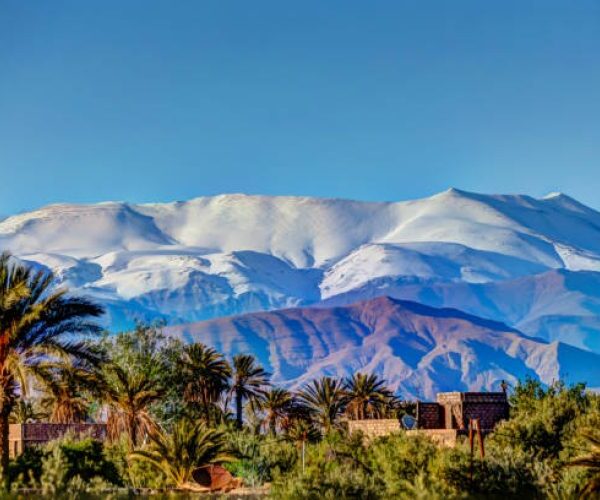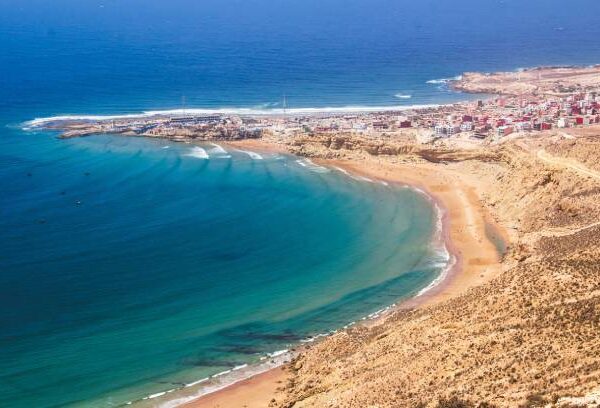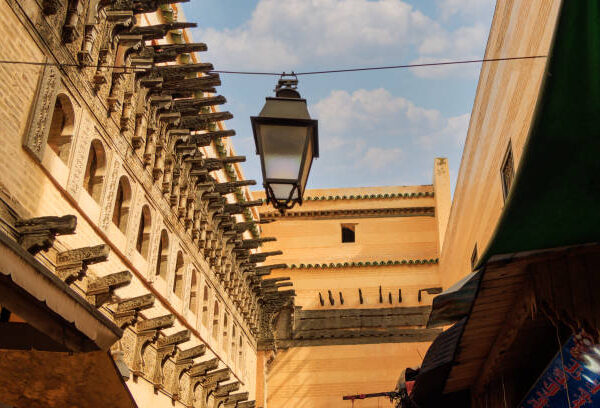.
🕌 Imperial Cities: A Glimpse into Morocco’s Rich History
Marrakech: The Red City
Marrakech, known as the “Red City” due to its distinct red sandstone buildings, is a vibrant metropolis that captivates visitors with its energy and charm. The city’s heart, Jemaa el-Fnaa, is a UNESCO World Heritage site bustling with street performers, food stalls, and artisans. Nearby, the Bahia Palace showcases intricate Moroccan architecture and lush gardens. The Majorelle Garden, once owned by Yves Saint Laurent, offers a botanical oasis with exotic plants and vibrant blue structures. Navigating through the narrow alleys of the Medina reveals a plethora of spices, textiles, and handcrafted goods.
Fes: The Cultural Capital
Fes, often considered Morocco’s spiritual heart, boasts one of the world’s oldest universities and a medina that transports visitors back in time. Fes el-Bali, a labyrinthine medina and UNESCO World Heritage site, is home to over 9,000 alleys. The Al Quaraouiyine University, founded in 859 AD, is recognized as the oldest existing university. Visitors can witness traditional leather dyeing methods at the Chouara Tanneries and admire the exquisite Marinid architecture of the Bou Inania Madrasa.
Rabat: The Political Capital
Rabat, Morocco’s capital, offers a blend of historical sites and modern infrastructure. The Kasbah of the Udayas is a fortified area with Andalusian gardens and panoramic views of the Atlantic. The Hassan Tower, an incomplete minaret of a mosque intended to be the world’s largest, stands as a testament to the city’s historical ambitions. The Mausoleum of Mohammed V showcases modern Alaouite dynasty architecture.
Meknes: The Imperial City
Meknes, one of Morocco’s four imperial cities, is known for its grand architecture and historical significance. Bab Mansour is considered one of the most beautiful gates in North Africa. The Royal Stables, which once housed thousands of horses, showcase the city’s grandeur. The Mausoleum of Moulay Ismail serves as the resting place of one of Morocco’s most powerful sultans.
🏞️ Natural Wonders: From Mountains to Desert
The Atlas Mountains
The Atlas Mountains stretch across Morocco, offering breathtaking landscapes and opportunities for outdoor adventures. Toubkal National Park is home to Mount Toubkal, the highest peak in North Africa at 4,167 meters. Visitors can experience traditional Berber culture and hospitality in the mountain villages. The region offers numerous hiking and trekking opportunities through scenic valleys and gorges.
The Sahara Desert
A trip to Morocco wouldn’t be complete without experiencing the Sahara Desert. Erg Chebbi and Erg Chigaga are famous sand dunes offering camel treks and overnight stays in Berber tents. The desert’s clear skies provide unparalleled views of the stars, and visitors can learn about the traditional lifestyles of the desert’s inhabitants.
The Atlantic and Mediterranean Coasts
Morocco’s coastline offers a mix of bustling ports and tranquil beaches. Essaouira is a coastal city known for its historic medina, seafood, and windsurfing. Agadir is a modern resort town with sandy beaches and a vibrant nightlife. Tangier, a port city at the crossroads of Europe and Africa, is rich in history and culture.
🏙️ Unique Cities and Towns
Chefchaouen: The Blue Pearl
Nestled in the Rif Mountains, Chefchaouen is renowned for its blue-painted buildings and relaxed ambiance. Wander through narrow, winding streets adorned in various shades of blue, shop for woven blankets and pottery, and hike to the Spanish Mosque for panoramic views of the city.
Ouarzazate: The Gateway to the Desert
Often referred to as the “Hollywood of Africa,” Ouarzazate has been the filming location for numerous movies and TV shows. Visit the historic Kasbah Taourirt, explore the UNESCO World Heritage site of Aït Benhaddou, and tour the film studios where productions like “Gladiator” and “Game of Thrones” were shot.
Asilah: The Artistic Town
Asilah, a charming coastal town, is renowned for its whitewashed buildings adorned with colorful murals. The annual Arts Festival attracts artists from around the world to create vibrant street art. Stroll through the medina’s peaceful streets and enjoy local seafood.
🍽️ Moroccan Cuisine: A Culinary Journey
Moroccan cuisine is a delightful fusion of Berber, Arab, and Mediterranean influences.
-
Tagine: A slow-cooked stew made with meat, vegetables, and aromatic spices.
-
Couscous: Steamed semolina grains often served with meat and vegetables.
-
Pastilla: A savory-sweet pie traditionally filled with pigeon or chicken.
-
Mint Tea: Known as “Moroccan whisky,” this sweet tea is a symbol of hospitality.
🛍️ Shopping: Souks and Markets
Morocco’s markets are a treasure trove of unique items.
-
Handicrafts: From intricate carpets to leather goods and ceramics.
-
Spices: Discover a variety of spices like saffron, cumin, and ras el hanout.
-
Argan Oil: Sourced from the argan tree, it’s used in cooking and cosmetics.
🛌 Accommodation: Where to Stay
Morocco offers a range of accommodations to suit every traveler’s needs.
-
Riads: Traditional Moroccan houses with interior gardens, often converted into guesthouses.
-
Desert Camps: Experience the Sahara by staying in a Berber tent under the stars.
-
Luxury Hotels: Modern amenities combined with Moroccan decor and hospitality.
🚗 Getting Around: Transportation Tips
-
Trains: ONCF operates a reliable train network connecting major cities.
-
Buses: CTM and Supratours offer comfortable intercity bus services.
-
Taxis: Petite taxis are for city travel, while grand taxis cover longer distances.
-
Car Rentals: Available for those wanting to explore at their own pace.
📅 Best Time to Visit
-
Spring (March to May): Pleasant temperatures and blooming landscapes.
-
Autumn (September to November): Mild weather ideal for sightseeing.
-
Summer (June to August): Hot, especially inland; coastal areas are cooler.
-
Winter (December to February): Snow in the mountains; mild in the south.
📝 Travel Tips
-
Language: Arabic and Berber are official languages; French is widely spoken.
-
Currency: Moroccan Dirham (MAD).
-
Cultural Etiquette: Dress modestly, especially in rural areas.
-
Health: Drink bottled water and be cautious with street food.
-
Safety: Generally safe, but be aware of pickpockets in crowded areas.
Embarking on a tour of Morocco promises an unforgettable adventure filled with rich history, diverse landscapes, and warm hospitality. Whether you’re exploring ancient medinas, trekking through mountains, or relaxing by the sea, Morocco offers something for every traveler.






